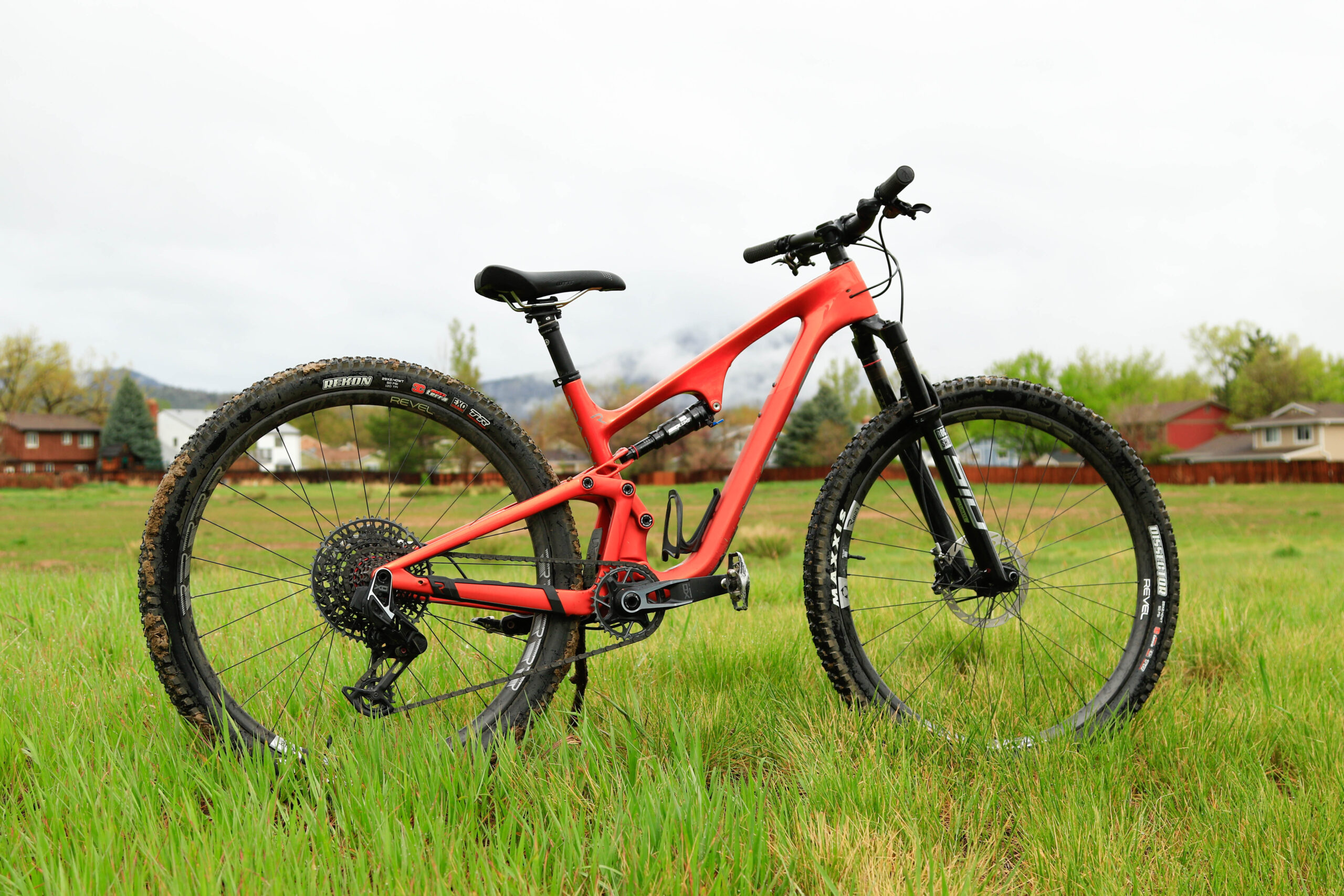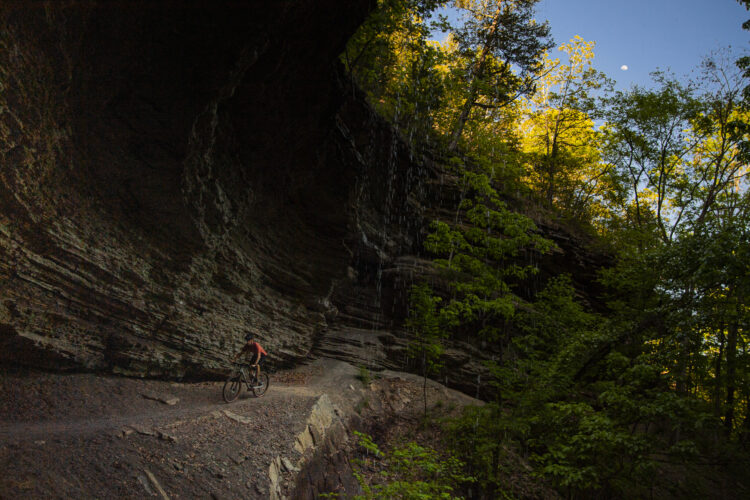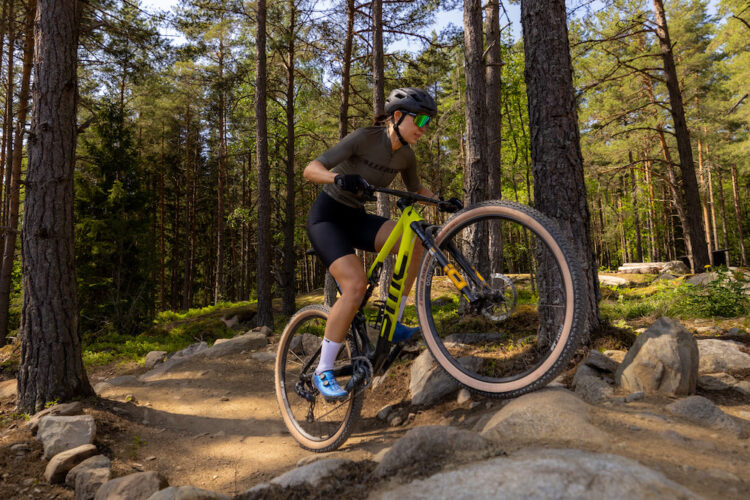
The Revel Ranger already had a lot going for it when it debuted. Its Canfield Balance Formula (CBF) suspension platform is complex compared to some other single-pivot bikes in the category, but gives an excellent pedaling feel, and progressive geometry gives the bike a blend of stability and agility. Revel must have known they had something good on their hands, because the latest update to the Ranger was fairly minimal.
The latest Ranger was given SRAM UDH compatibility, which also makes it compatible with Eagle Transmission. Revel also made the linkage and hardware on the rear triangle bigger, improving lateral stiffness in the rear by 20% without adding weight.

About the Revel Ranger
Other than that, the Ranger is largely the same, aside from two new colors, which isn’t a bad thing. It’s a cross-country bike, with trail bike characteristics. In the rear, it has 115mm of travel and that’s paired with a 120mm fork.

At 5’8″ tall, I’ve been riding a size medium, so I’ll talk a little about the geometry. The seat tube is short for folks who want a longer dropper post, and for an XC bike, the chainstays are somewhat long at 436mm across the board.
The head tube angle is 67.5°, reminding riders that this still is an XC bike with sharp handling. The wheelbase seems pretty moderate–short for a trail bike, but long-ish for an XC bike at 1,170mm. The seat tube angle is fairly steep for an XC bike too at 75.3°. While it may not seem steep for bikes these days, the head tube angle doesn’t really necessitate a steeper STA. Lastly, reach is moderate, and some might say lengthy for an XC/trail bike at 453mm for the size medium.
The Ranger frame is full carbon, from rear axle to head tube. On the latest version, Revel added a debris guard or hard mud flap to keep the linkage clean. This build includes a parts kit with some trail touches, but one that really adds to the Ranger’s cross-country intentions.
We tested the XO Eagle Transmission build which gives it said drivetrain, SRAM’s new Level Stealth brakes, RockShox SID Ultimate suspension, Maxxis Rekon and Dissector tires, and your choice of wheels, starting at $8,499. With a set of Revel’s FusionFiber wheels, builds are priced between $9,000-$10,000.

Climbing on the Revel Ranger
I’m a big fan of the CBF platform ever since my first ride on a Revel shortly after the brand debuted. And I’m on my second owned bike with the suspension design.
For a premium 27lb, full-carbon, 115mm lightweight trail bike, the Revel pedals as you’d expect; delightfully. The bike is juiced to the gills with top-shelf parts too, like Revel’s R27 carbon wheels, which help it pick up speed as soon as you mash on the pedals. Typical of the CBF platform is the feeling that the Ranger has some extra propulsion as your quads hammer on the cranks.
The Ranger accelerates quickly and keeps its speed well. On flats, you really can’t help but hammer away because the results are rewarding. Maybe you’re more of a Rascal or Rail type of rider that likes the stable downhills on a bigger travel bike, but the Ranger reminds me why I love XC bikes; because it’s fun going fast uphill too.
I never suffered any lapses in traction with the CBF and the rear wheel stayed in close contact with the ground marching up technical ascents and rock gardens. Some XC bikes feel like they don’t get deep enough into their travel for decent traction on technical climbs, but I was very happy with how the Ranger’s suspension gave it a balance of cushion, traction, and efficiency on the ups.
There was one area I thought could be improved on the Ranger while climbing. Sometimes the front end of the bike felt a little long and made it hard to weight the front wheel, giving it an antsy or unplanted feel in some pedaling situations. Maybe this is due to the steeper seat tube angle with a longer reach and still a moderate head tube angle. This was more noticeable on steep climbs where I had to be cognizant of pulling myself into the cockpit for better weight distribution on the front wheel.
The bike also gets a short offset fork paired with a steeper HTA, giving it very quick steering characteristics. The bike as a whole didn’t feel too long around switchbacks and this could be why.

Descending
Being such a light and stiff bike on stout wheels, the Ranger carries its speed very well on the downhills too. It doesn’t take but a few pedal strokes into a decline to get up to speed and then you’re carving your way around berms.
The CBF behaved the way it has in the past for me, getting out of my way quickly and smoothing out square-edge rocks and small bumps. I found plenty of support in the mid-stroke too and the Ranger is just good clean fun on the descents. It’s happy to hug the trail and carve all the way down or hit the bonus kickers off to the side.
On big drops, like the one pictured above, I never noticed a harsh bottom out, but 115mm of travel is only as plush as it can be.
The length of the Ranger isn’t necessarily long for an XC/trail bike, but if you call it an XC bike, it is a little long. The bike could have been pushed harder into either side, but I believe it errs more on the XC side, with component choices like the RockShox SID and 180/160mm brake rotors. That wheelbase and reach length give the Ranger an upper hand on rowdier descents, keeping it stable and postured.
Most people aren’t going to gravitate toward a bike like the Ranger because they’re riding a bunch of steep, washed out trails though. It’s in smooth, flowy XC/trail terrain that the Ranger shines with its seamless CBF suspension behavior, stable geometry, and stiff frame.

Component check
Revel makes the choices in builds easy for you. You can save a good bit of money right now if you opt for the V1 Ranger, and remember, the riding experience is nearly the same. You may notice an increase in stiffness from the rear triangle, but you may not.
If you’re into SRAM’s new Eagle Transmission, do opt for the V2. The main advantage of the current Ranger is that it’s SRAM direct mount compatible and you may fare better in the long run with the improved linkage. There are more affordable builds with 12-speed Shimano XT and SRAM GX Eagle, for $6,000 – $7,000, but the V1 is about $1,400 cheaper on both builds and at the time of publication, they’re still available. And why get the V2 anyway if you’re not getting the latest and greatest tech?

The Eagle Transmission is very nice though. The shifting is quick and crisp and reliable. I raced the Ranger at 18 Hours of Fruita, and while everyone was washing the moon dust off their chain and sprockets after every lap, I showed the new SRAM drivetrain no mercy and it took the grit in stride.
The SRAM Level Stealth brakes performed admirably too and I’m happy to say that I didn’t have any fading issues on them, which was not always the case on review bikes in the past with Level brakes.
Pros and Cons of the Revel Ranger V2
Pros
- Great suspension manners
- Stiff and responsive frame
- Eagle Transmission compatible, tougher frame
Cons
- Front end can feel long on climbs
Bottom line
There’s a whole lot to like about the latest version of the Revel Ranger. It’s also refreshing to have a second version of a bike that isn’t a sweeping overhaul. The Ranger keeps what was great about the first version and makes it tougher and more future-proof with UDH compatibility.
If you’re looking for a fast, stiff, and responsive cross-country bike with trail bike capability, the Revel Ranger delivers.






